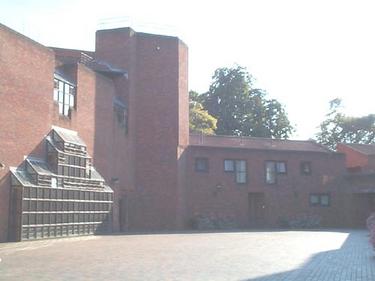A walk around Cambridge
Colleges beginning with 'R'
(for no reason other than that they were there)
Robinson College
The forbidding, prison-like exterior of Robinson College seems to promise little but solid construction and utilitarian living accommodation. It's only when you see the entrance, tucked away in the trees, that you begin to get a hint of the games that are being played with the design:
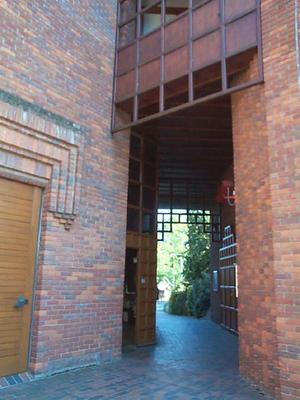 |
It's all straight lines and right-angles, but somehow they manage to give the illusion of crooked, crazy corners. The squares -- such boring shapes that they gave their name to the terminally uncool -- are used inventively, stacked up like building-blocks, their plainness accreted into ornament; and in conjunction with the irregular brickwork (not quite echoed in the floor) the effect is subtly mindbending, drawing the eye in and confusing its sense of normality. In places the straight lines almost produce curves; the inner entrance is indisputably an archway, and the passage leading up to it seems to bend round. Even the patterns in the warm colours of the bricks seem to suggest flames, swirling shadows, rather than the regular rectangles of which they really consist.
And what is that pattern above the entrance? It echoes the squares which lead us inwards, but it also seems to harmonise with the fortress-like walls seen from the outside, irresistably suggesting to the mind the shape of a portcullis. Suddenly the crazy angle of the entrance looks more like the angle of a guillotine blade as seen from below; the blocks of the repeated pattern seem precariously poised above us as we walk inside. |
The quadrangle has a kind of glassy stillness, silent and shining in the relentless sunlight. It feels tense, expectant. The few patches of shadow offer no respite to the eye, as they only seem to echo the endless motif of squares and rectangles, occasionally cut into triangles. We are surrounded by high walls and blind windows, yet there is a feeling of being watched.
Suddenly we see what we, and the buildings around us, have unknowingly been waiting for:
The stained glass windows of the chapel swell out of the brickwork, a mad mosaic, bending the straight lines like a fish-eye lens. There are other distortions, too; the apparently-straight lines don't actually line up, the windows are all different sizes, the irregular stepwise outline is echoed in the wilfully asymmetrical flourish around the door. Which line is longer? The eye is distracted by the explosion of colour and baffled by the constant undermining of what it thinks it sees. |
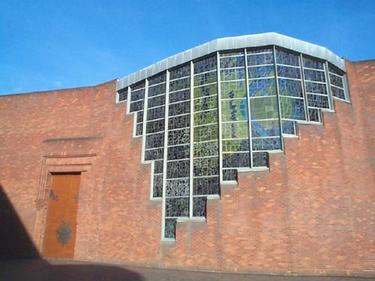 |
From here on in it's all unlit passageways, staircases flanked by the persistent rectangles and crenellations, windowless boxes where the only things growing are the outcrops of squares. It's compelling and twisted, a kind of black joke at the expense of the rules of geometry and perspective, hidden like a dark jewel within the mute and unpresupposing red-brick walls.
Ridley Hall
From Robinson to Ridley Hall, another red-brick college and yet a total contrast. Here the bricks are warm and welcoming:
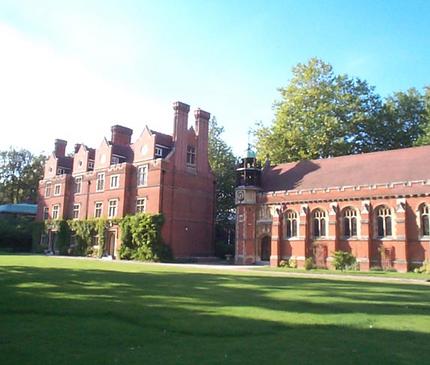 |
It's every bit as deserted, but here the silence is gentler. No heat-heavy air or sharp lines here; the rays fall in soft ripples through the trees like the faintest of breezes. Everything is what it seems, from the natural grass (complete with mushroom-dotted 'fairy rings') to the dignified Victorian chimneys. The chapel offers a sedately-seated row of arched windows, with some understated stained glass; yet the bright greenery prevents the buildings, for all their decorousness, from seeming aloof. If Robinson was tensely watching and waiting, Ridley Hall is comfortably settled and smiling benignly on its visitors beneath calm blue skies. |
The pastoral scene is enhanced by the tiny orchard with its gnarled apple trees; they expend no extra effort on being ornamental, and when we passed by the floor beneath them was littered with fallen fruit. Earthly paradise though this place may have seemed to be, I felt that no harm could come from beating the wasps to a windfall, except for the possibility that the tiny, tart, crunchy green mouthful might produce a touch of indigestion.
The only thing that disturbed the sense of a slower and more peaceful age was the intrusion of scaffolding on the scene, and in deference to the spirit of the college I have carefully elided that from my photograph.
Rivers and rambling
In an essentially flat landscape, the details of light and shade become paramount in creating contours, reflected glimpses of the sublime. I could have stood for hours just watching the bright waves of sunlight on the river:
The willows trail their fingers along the surface of the river as if to gather up the jewels that the sun has cast on the waters. Or perhaps, as their name suggests, they are weeping, and the droplets that glitter beneath them are their tears.
If they are weeping, though, it is not a trickle of tears but rather a storm of sobs. It is a noisy kind of light, and this is not just a reflection of the crowds of chattering sunbathers who are so conveniently hidden behind the camera; it is pale and bright and sparkling like radio static, filling the mind and dazzling the eye. The splashing of wavelets against the artificial shores just add to the wet white noise.
| 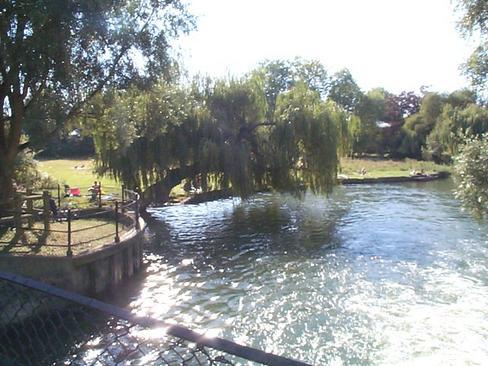 |
By contrast, it may be more calming to take the long view:
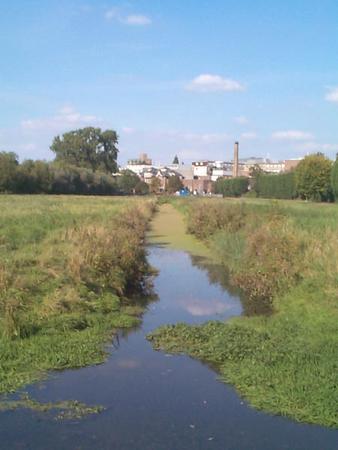 |
The river stretches into the distance, with the city standing on the horizon like a promise of something, anything, but not now, maybe tomorrow. The grass merges with the river, the boundaries undefined.
It's peaceful. Too peaceful.
Further along the water we see what happens when we stand still for too long; the stagnant water is dull and flat, no longer reflecting the open sky. At this distance it blends into the banks, merely a soft greenish haze over the water; close up it will be a slimy, stinking scab over the water that is the land's lifeblood. It adds to the illusion that the banks of the river meet at the city, that there is a point, a purpose; but in reality it is just a vanishing point.
I focus on the chimney in the distance, standing over a trimmed hedge; symbols of agency and industry in the face of this suffocating silence. |
home

